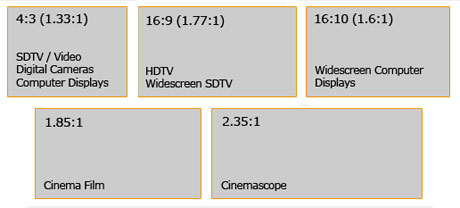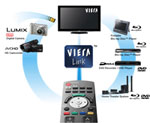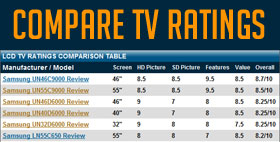HDTV Glossary, Terms and Concepts
By Jack Burden
120Hz/240Hz/480Hz - These are releated to the screen refresh rates of LCD televisions. Standard LCDs are 60Hz, they redraw the screen 60 times per second. These double and redouble the speed in an effort to combat motion blur and judder. Sometimes this is accomplished by manipulating the backlight and are not "true" 120Hz. Manufacturers have come up with many names for this feature, Sony calls it MotionFlow, Sharp calls it AquoMotion, Samsung calls it AutoMotion Plus, LG calls it TruMotion but they are all just names for the higher refresh rates of their 120+ Hz models.
24p - 24 frame per second progressive scan video. Since film is recorded at 24 frames per second TVs that have this feature will not have judder when displaying film source.
Aspect Ratio - Ratio of width to height of the screen. Most TVs were 4:3 screens until recently when 16:9 widescreen became popular. Widescreen computer monitors are often 16:10 and there are a few TVs that are available that are 2.35:1, a ratio often seen in film.

ATSC - named for the Advanced Television System Committee, ATSC is the digital replacement for NTSC.
 Bezel - the frame of the TV that surrounds the screen.
Bezel - the frame of the TV that surrounds the screen.
CFL Back light - LCD TV back lighting provided by a Cold Cathode Flourescent Light. This is the back light found in most LCD televisions.
 Component Video - Analog video inputs that split the video signal between up to three cables. Video information is either sent in RGB or YPbPr signals. Component video can carry progessive scan and high deifnition signals.
Component Video - Analog video inputs that split the video signal between up to three cables. Video information is either sent in RGB or YPbPr signals. Component video can carry progessive scan and high deifnition signals.
 Composite Video - An analog video input where the video signal is carried on a single cable. It cannot carry high definition or progressive scan signals.
Composite Video - An analog video input where the video signal is carried on a single cable. It cannot carry high definition or progressive scan signals.
Contrast Ratio - The ratio of luminance of the brightest white to the darkest black that a TV can display at any one time.
 Device Control - HDMI connections between devices not only carry video and audio they also can carry control signals. Manufacturers call this different things such as Viera Link or Bravia Link and it allows a single remote to control various devices of the same brand. It can also do things like automatically turning on a Blu Ray player when that input is selected.
Device Control - HDMI connections between devices not only carry video and audio they also can carry control signals. Manufacturers call this different things such as Viera Link or Bravia Link and it allows a single remote to control various devices of the same brand. It can also do things like automatically turning on a Blu Ray player when that input is selected.
DLNA - Digital Living Network Alliance, a standard that allows communication and content sharing between DLNA compatible devices. Unlike manufacturer specific features, DLNA is a standard and will work across brands.
Dynamic Contrast Ratio - This is the best contrast a display can do over time, in reality it is a marketing device to allow manufacturers to advertise extreme contrast ratios by manipulating conditions to give the best possible result. A calibrated display's contrast ratio will never approach the Dynamic Contrast Ratio.
 HDMI - High Definition Multimedia Interface. A digital input format that can carry uncompressed video and up to 8 audio channels. It can also send and receive signals for compatible device control and it has a built in content protection.
HDMI - High Definition Multimedia Interface. A digital input format that can carry uncompressed video and up to 8 audio channels. It can also send and receive signals for compatible device control and it has a built in content protection.
 Internet Connectivity - Many HDTVs are now equipped with a built in RJ45 (ethernet) input or WiFi (built in or optional) to enable them to connect directly to the internet. They don't provide the same access as a computer with a web browser but they offer features like Yahoo! widgets for instant access to news, sports scores, weather, stock quotes and more. Many can connect to YouTube or other video clip services, picture sharing services like Flickr and social networking sites likes Twitter or Facebook. Video on demand services such as NetFlix, HULU or Amazon on demand are also available. Different manufacturers have different licensing deals so check to see if the TV can connect to features that interest you. Like 120Hz, manufacturers have their own names for this service but the features are going to be similar.
Internet Connectivity - Many HDTVs are now equipped with a built in RJ45 (ethernet) input or WiFi (built in or optional) to enable them to connect directly to the internet. They don't provide the same access as a computer with a web browser but they offer features like Yahoo! widgets for instant access to news, sports scores, weather, stock quotes and more. Many can connect to YouTube or other video clip services, picture sharing services like Flickr and social networking sites likes Twitter or Facebook. Video on demand services such as NetFlix, HULU or Amazon on demand are also available. Different manufacturers have different licensing deals so check to see if the TV can connect to features that interest you. Like 120Hz, manufacturers have their own names for this service but the features are going to be similar.
Judder - also called telecine judder, this is an unwanted effect from converting film, which is 24 frames per second, to video which is 29.97 frames per second. It is most noticeable as a skipping effect during slow camera pans.

LED Edge Lighting
allows for extremely
slim construction
LED Edge Lighting - A form of LCD television back lighting where LED lights are placed around the edge of the panel, the color and contrast are generally superior to fluorescent light and also allows for extremely thin construction.
Light Sensors - Many newer HDTVs are equipped with light sensing devices that let the TV automatically adjust the picture and backlighting based on the lighting in the room. This feature can save energy but not a very significant amount. If your television is professionally calibrated then this feature will negate that as it changes settings on he television.
Local Dimming LED - A form of LCD television back light that uses banks of controllable LED lights behind the panel. The light banks can be dimmed and brightened to give far superior contrast to fluorescent back lighting. Most use white LEDs but red, green and blue LEDs have also been used for more color control. This is considered the best currently available back lighting for LCD TVs.
Motion Blur - Motion blur is a phenomenon specific to LCD panels, it occurs when the response time and refresh rate of the TV cannot keep up with motion on the screen which can trails to appear behind fast moving objects.
NTSC - named for the National Television System Committee, NTSC is the analog television system used in most of the Americas, Japan, South Korea, Taiwan, Burma, and some Pacific island nations and territories.
PAL - Phase Alternating Line, the broadcast television standard used in much or Europe, Africa, South Asia and Austrailia
QAM - Quadrature amplitude modulation, the standard that digital cable systems use to transmit video
Refresh Rate - The number of times the screen is redrawn per second, represented as Hertz.
Resolution - the number of pixels on the screen, often expressed as width x height or number of vertical lines of resolution. 1920x1080 or 1080p are the same, the screen has 2,073,600 individual pixels.
Response Time - This specification represents the amount of time it takes for one pixel to go from active (black) to inactive (white) and back to black again. Applies only to LCD panels.
 RS232 - A serial port often used to connect professional calibration or control hardware to the television.
RS232 - A serial port often used to connect professional calibration or control hardware to the television.
 S-Video - An analog video input that splits the video into two signals, it uses a 4 pin DIN connector on a single cable. It cannot carry high definition or progressive scan video but offers a better standard definition signal than composite video.
S-Video - An analog video input that splits the video into two signals, it uses a 4 pin DIN connector on a single cable. It cannot carry high definition or progressive scan video but offers a better standard definition signal than composite video.
SECAM - Séquentiel couleur à mémoire, the broadcast standard used in France, Russia, Central Asia and some of Africa.
THX - THX is a quality assurance standard. To be THX certified a television must meet certain standards of predicitable reproduction of film source content.









